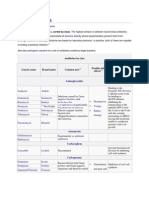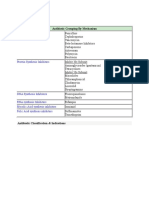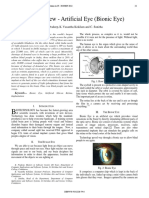Antibiotics by Class
Antibiotics by Class
Uploaded by
Herlin Ajeng NurrahmaCopyright:
Available Formats
Antibiotics by Class
Antibiotics by Class
Uploaded by
Herlin Ajeng NurrahmaCopyright
Available Formats
Share this document
Did you find this document useful?
Is this content inappropriate?
Copyright:
Available Formats
Antibiotics by Class
Antibiotics by Class
Uploaded by
Herlin Ajeng NurrahmaCopyright:
Available Formats
dr.
Ridha Wahyutomo
Antibiotics by class
Generic name
Brand names
Common uses
Possible side effects
Mechanism of action
Aminoglycosides
Amikacin Gentamicin Kanamycin Neomycin Netilmicin Streptomycin Tobramycin Paromomycin Geldanamycin Herbimycin
Amikin Garamycin Kantrex Mycifradin Netromycin Nebcin Humatin Ansamycins Experimental, as antitumor antibiotics Infections caused by Gramnegative bacteria, such as Escherichia coli and Klebsiella particularly Pseudomonas aeruginosa. Effective against Aerobic bacteria (not obligate/facultative anaerobes) and tularemia. Binding to the bacterial 30S ribosomal subunit (some work by binding to the 50S subunit), inhibiting the translocation of the peptidyl-tRNA from the A-site to the P-site and also causing misreading of mRNA, leaving the bacterium unable to synthesize proteins vital to its growth.
Hearing loss Vertigo Kidney damage
Carbacephem Loracarbef Lorabid prevents bacterial cell division by inhibiting cell wall synthesis.
Carbapenems Ertapenem Doripenem Imipenem/Cilastatin Invanz Finibax Primaxin Bactericidal for both Grampositive and Gram-negative organisms and therefore useful for empiric broad-spectrum antibacterial coverage. (Note MRSA resistance to this class.) Gastrointestinal upset and diarrhea Nausea Seizures Headache Rash and allergic reactions
Inhibition of cell wall synthesis
Meropenem
Merrem
Cephalosporins (First generation) Cefadroxil Cefazolin Cefalotin or Cefalothin Cefalexin Duricef Ancef Keflin Keflex Gastrointestinal upset and diarrhea Nausea (if alcohol taken Same mode of action as other beta-lactam antibiotics: disrupt the synthesis of the concurrently) peptidoglycan layer of bacterial cell walls. Allergic reactions
Cephalosporins (Second generation) Cefaclor Cefamandole Cefoxitin Cefprozil Cefuroxime Ceclor Mandole Mefoxin Cefzil Ceftin, Zinnat Gastrointestinal upset and diarrhea Nausea (if alcohol taken Same mode of action as other beta-lactam antibiotics: disrupt the synthesis of the concurrently) peptidoglycan layer of bacterial cell walls. Allergic reactions
Cephalosporins (Third generation) Cefixime Cefdinir Cefditoren Cefoperazone Cefotaxime Cefpodoxime Ceftazidime Ceftibuten Ceftizoxime Ceftriaxone Rocephin Cephalosporins (Fourth generation) Cefepime Maxipime Gastrointestinal upset and diarrhea Nausea (if alcohol taken Same mode of action as other beta-lactam antibiotics: disrupt the synthesis of the concurrently) peptidoglycan layer of bacterial cell walls. Allergic reactions Suprax Omnicef, Cefdiel Spectracef Cefobid Claforan Vantin Fortaz Cedax Gastrointestinal upset and diarrhea Nausea (if alcohol taken Same mode of action as other beta-lactam antibiotics: disrupt the synthesis of the concurrently) peptidoglycan layer of bacterial cell walls. Allergic reactions
Cephalosporins (Fifth generation) Ceftobiprole Used to treat MRSA Gastrointestinal upset and diarrhea Nausea (if alcohol taken Same mode of action as other beta-lactam antibiotics: disrupt the synthesis of the concurrently) peptidoglycan layer of bacterial cell walls. Allergic reactions
Glycopeptides Teicoplanin Vancomycin Vancocin Macrolides Azithromycin Clarithromycin Dirithromycin Erythromycin Roxithromycin Troleandomycin Telithromycin Spectinomycin TAO Ketek Pneumonia Antimetabolite, Anticancer Monobactams Aztreonam Azactam Same mode of action as other beta-lactam antibiotics: disrupt the synthesis of the peptidoglycan layer of bacterial cell walls. Visual Disturbance, Liver Toxicity.[3] Zithromax, Sumamed, Zitrocin Biaxin Dynabac Erythocin, Erythroped Streptococcal infections, syphilis, respiratory infections, mycoplasmal infections, Lyme disease Nausea, vomiting, and diarrhea (especially at higher doses) Jaundice inhibiting peptidoglycan synthesis
inhibition of bacterial protein biosynthesis by binding irreversibly to the subunit 50S of the bacterial ribosome, thereby inhibiting translocation of peptidyl tRNA.
Penicillins Amoxicillin Ampicillin Azlocillin Carbenicillin Cloxacillin Dicloxacillin Flucloxacillin Mezlocillin Meticillin Nafcillin Oxacillin Penicillin Piperacillin Ticarcillin Polypeptides Bacitracin Eye, ear or bladder infections; usually applied directly to the eye or inhaled into the lungs; rarely given by injection Inhibits isoprenyl pyrophosphate, a molecule which carries the building blocks of the peptidoglycan bacterial cell wall Kidney and nerve damage (when outside of the inner membrane given by injection) Interact with the bacterial cytoplasmic membrane, changing its permeability. Tegopen Dynapen Floxapen Wide range of infections; penicillin used for streptococcal infections, syphilis, and Lyme disease Gastrointestinal upset and diarrhea Allergy with serious anaphylactic reactions Brain and kidney damage (rare) Novamox, Amoxil Principen
Same mode of action as other beta-lactam antibiotics: disrupt the synthesis of the peptidoglycan layer of bacterial cell walls.
Colistin Polymyxin B
Quinolones Ciprofloxacin Enoxacin Gatifloxacin Levofloxacin Lomefloxacin Moxifloxacin Norfloxacin Ofloxacin Trovafloxacin Grepafloxacin Sparfloxacin Temafloxacin Cipro, Ciproxin, Ciprobay Penetrex Tequin Levaquin Maxaquin Avelox Noroxin Floxin, Ocuflox Trovan Raxar Zagam Omniflox Withdrawn Withdrawn Withdrawn Withdrawn Urinary tract infections, bacterial prostatitis, communityacquired pneumonia, bacterial diarrhea, mycoplasmal infections, gonorrhea Nausea (rare), irreversible damage to central nervous system (uncommon), tendinosis (rare) inhibit the bacterial DNA gyrase or the topoisomerase IV enzyme, thereby inhibiting DNA replication and transcription.
Sulfonamides Mafenide Sulfonamidochrysoidine (archaic) Sulfacetamide Sulfadiazine Sulfamethizole Sulfanilimide (archaic) Sulfasalazine Sulfisoxazole Trimethoprim TrimethoprimSulfamethoxazole (Cotrimoxazole) (TMP-SMX) Demeclocycline Doxycycline Minocycline Oxytetracycline Trimpex Bactrim, Septra Tetracyclines Declomycin Vibramycin Minocin Terramycin Sumycin, Achromycin V, Steclin Syphilis, chlamydial infections, Lyme disease, mycoplasmal infections, acne rickettsial infections, *malaria *Note: Malaria is caused by a protist and not a bacterium. Potentially Permanent Gastrointestinal upset Sensitivity to sunlight Potential toxicity to mother and fetus during pregnancy Enamel hypoplasia (staining of teeth) transient depression of bone growth Azulfidine Micro-Sulfon Urinary tract infections (except sulfacetamide and mafenide); mafenide is used topically for burns Prontosil Nausea, vomiting, and diarrhea Allergy (including skin rashes) Crystals in urine Kidney failure Decrease in white blood cell count Sensitivity to sunlight Folate synthesis inhibition. They are competitive inhibitors of the enzyme dihydropteroate synthetase, DHPS. DHPS catalyses the conversion of PABA (paraaminobenzoate) to dihydropteroate, a key step in folate synthesis. Folate is necessary for the cell to synthesize nucleic acids (nucleic acids are essential building blocks of DNA and RNA), and in its absence cells will be unable to divide.
inhibiting the binding of aminoacyl-tRNA to the mRNA-ribosome complex. They do so mainly by binding to the 30S ribosomal subunit in the mRNA translation complex.
Tetracycline
Others Arsphenamine Salvarsan Spirochaetal infections
(obsolete) meningitis, MRSA, topical use, or for low cost internal treatment. Historic: typhus, cholera. gram negative, gram positive, anaerobes acne infections, prophylaxis before surgery acne infections, prophylaxis before surgery Antituberculosis
Chloramphenicol
Chloromycetin
Rarely: aplastic anemia.
Inhibits bacterial protein synthesis by binding to the 50S subunit of the ribosome
Clindamycin Lincomycin Ethambutol Fosfomycin Fusidic acid Furazolidone Isoniazid Linezolid Metronidazole Mupirocin Nitrofurantoin Platensimycin Pyrazinamide Quinupristin/Dalfopristin Rifampicin (Rifampin in US) Thiamphenicol
Cleocin Lincocin Myambutol Monurol Fucidin I.N.H. Zyvox Flagyl Bactroban Macrodantin, Macrobid
Antituberculosis VRSA Giardia
Antituberculosis Syncercid mostly Gram-positive and mycobacteria Gram-negative, Gram-positive, anaerobes. widely used in veterinary medicine. Reddish-orange sweat, tears, and Binds to the subunit of RNA polymerase urine to inhibit transcription Lacks known anemic sideeffects. A chloramphenicol analog. May inhibit bacterial protein synthesis by binding to the 50S subunit of the ribosome
Tinidazole Dapsone Clofazimine Avlosulfon Lamprene Antileprotic Antileprotic
You might also like
- Removable Prosthodontics: Textbook ofDocument13 pagesRemovable Prosthodontics: Textbook ofRico Anas0% (3)
- Top 300 Drugs Pocket Reference Guide (2021 Edition)From EverandTop 300 Drugs Pocket Reference Guide (2021 Edition)Rating: 5 out of 5 stars5/5 (1)
- Adult Infectious Disease Bulletpoints HandbookFrom EverandAdult Infectious Disease Bulletpoints HandbookRating: 4.5 out of 5 stars4.5/5 (9)
- QSTR06319 Oliver John PDFDocument1 pageQSTR06319 Oliver John PDFJohn OliverNo ratings yet
- Antibiotics PDFDocument8 pagesAntibiotics PDFSarah JaneNo ratings yet
- Pharmacology - Chapter 29Document5 pagesPharmacology - Chapter 29Ashley-Michelle LewisNo ratings yet
- Antimicrobial Table BasicDocument7 pagesAntimicrobial Table BasicPAschoolstuffNo ratings yet
- Antibiotics by ClassVITEK-Bus-Module-1-Antibiotic-Classification-and-Modes-of-Action-1.pDocument6 pagesAntibiotics by ClassVITEK-Bus-Module-1-Antibiotic-Classification-and-Modes-of-Action-1.pJameston BostreNo ratings yet
- List of AntibioticsDocument10 pagesList of AntibioticsAia JavierNo ratings yet
- AntibioticsDocument11 pagesAntibioticsSeshu Kelam100% (3)
- Overview of AntibioticsDocument5 pagesOverview of AntibioticsakshahinbdNo ratings yet
- AntibioticsDocument9 pagesAntibioticsprince1500100% (1)
- List of AntibioticsDocument9 pagesList of Antibioticsdesi_mNo ratings yet
- Nursing NotesDocument6 pagesNursing NotesLinguumNo ratings yet
- List of Antibiotics: Following Is The List Of, Sorted by Class. The Highest Division Is BetweenDocument11 pagesList of Antibiotics: Following Is The List Of, Sorted by Class. The Highest Division Is BetweenBhanuprakash PuthalapattuNo ratings yet
- Pseudomonas Aeruginosa. Effective: Antibiotics by ClassDocument4 pagesPseudomonas Aeruginosa. Effective: Antibiotics by ClassDocFrankNo ratings yet
- Generic Name Brand Names Common Uses Possible Side Effects Mechanism of ActionDocument13 pagesGeneric Name Brand Names Common Uses Possible Side Effects Mechanism of Actionangel3424No ratings yet
- AntibioticsDocument10 pagesAntibioticsStevhenson PortacioNo ratings yet
- List of AntibioticsDocument8 pagesList of AntibioticsMiguel Angel Ortega100% (1)
- List of AntibioticsDocument11 pagesList of AntibioticsD. BarNo ratings yet
- First Generation Ciprofloxacin (Cipro) : Cell Wall SynthesisDocument17 pagesFirst Generation Ciprofloxacin (Cipro) : Cell Wall SynthesisVAnh NguyenNo ratings yet
- Pharmacology-Antibiotic 2021Document52 pagesPharmacology-Antibiotic 2021Ngọc VânNo ratings yet
- Antibiotics Part 1Document6 pagesAntibiotics Part 1Maaz NasimNo ratings yet
- List of Antibiotics - Wikipedia, The Free EncyclopediaDocument11 pagesList of Antibiotics - Wikipedia, The Free EncyclopediaRamesh KumarNo ratings yet
- AntibioticsDocument4 pagesAntibioticsVladimir GurjanovNo ratings yet
- Antibiotic Classification & Mechanism: Derek Moore MDDocument11 pagesAntibiotic Classification & Mechanism: Derek Moore MDPutriCaesarriniNo ratings yet
- 1 AntibioticsDocument144 pages1 AntibioticsRhomizal MazaliNo ratings yet
- Chemotherapeutic DrugsDocument122 pagesChemotherapeutic Drugsdex7reme100% (1)
- Chemotherapy NotesDocument9 pagesChemotherapy Notesnileshkumarhjoshi942No ratings yet
- Pharmacology AntibioticsDocument70 pagesPharmacology Antibioticsmaggie100% (2)
- Pharmacotherapy of ENT InfectionsDocument86 pagesPharmacotherapy of ENT InfectionsHoque Mohammed Newaz ShorifulNo ratings yet
- AntibacterialDocument18 pagesAntibacterialRafia Rayana btbcNo ratings yet
- Cephalosporins 2018Document33 pagesCephalosporins 2018Harsha MaheshwariNo ratings yet
- Metronidazole: Mechanism of Antibacterial Action Is Unclear, But NeedsDocument60 pagesMetronidazole: Mechanism of Antibacterial Action Is Unclear, But NeedsmmydungNo ratings yet
- Year Two Drugs: Proneuduction)Document4 pagesYear Two Drugs: Proneuduction)Caine ReganNo ratings yet
- Antibiotic Grouping by MechanismDocument11 pagesAntibiotic Grouping by MechanismalterNo ratings yet
- Protein Synthesis InhibitorsDocument28 pagesProtein Synthesis InhibitorsMaha JabeenNo ratings yet
- Inhibitor of Cell Wall Synthesis (ICWS) : Proteus ComboDocument12 pagesInhibitor of Cell Wall Synthesis (ICWS) : Proteus Comboflomax23100% (2)
- AntibioticsDocument6 pagesAntibioticsCyrus100% (1)
- Anti Fungal: Dr. Dr. Nico L Lumbuun, SPFKDocument45 pagesAnti Fungal: Dr. Dr. Nico L Lumbuun, SPFKAudhrey BNo ratings yet
- CefphalosporinsDocument31 pagesCefphalosporinsmariamanoNo ratings yet
- Antibiotics PharmacologyDocument27 pagesAntibiotics PharmacologyKevil LoriyaNo ratings yet
- Pharm Drug FileDocument46 pagesPharm Drug FileunknownxemNo ratings yet
- ChemotherapyDocument66 pagesChemotherapyElias HaimanotNo ratings yet
- Tmd175 Slide Pharmacology of Antifungi Anthelminthics AntiprotozoalDocument38 pagesTmd175 Slide Pharmacology of Antifungi Anthelminthics AntiprotozoalYeni SuwitaNo ratings yet
- Antibiotics ClassificationDocument7 pagesAntibiotics ClassificationTabarcea Dorin100% (1)
- Antibiotics: Microbial Control Antimicrobial AgentsDocument25 pagesAntibiotics: Microbial Control Antimicrobial AgentsMohammed Moutasim AyoubNo ratings yet
- Antimycobacterial DrugsDocument4 pagesAntimycobacterial DrugsRani SujithNo ratings yet
- A. Chemical StructureDocument34 pagesA. Chemical StructureAmit GaurNo ratings yet
- Antibiotics Antiviral Antifungal Antimalarial Antiseptic & Disinfectant Agents Antiinflammatory & AntirheumaticDocument69 pagesAntibiotics Antiviral Antifungal Antimalarial Antiseptic & Disinfectant Agents Antiinflammatory & AntirheumaticNop PiromNo ratings yet
- Infectious DiseaseDocument31 pagesInfectious DiseasemirunahorgaNo ratings yet
- Antibiotics F MCP 1Document37 pagesAntibiotics F MCP 1Mohamed ElraiyNo ratings yet
- Drug Use in LeprosyDocument23 pagesDrug Use in LeprosyIrish Nicole DCNo ratings yet
- Antimicrobial AgentsDocument3 pagesAntimicrobial AgentsErnie G. Bautista II, RN, MD100% (2)
- Pharmacotherapy ENTDocument38 pagesPharmacotherapy ENTfinney blessedNo ratings yet
- Mark M Calban MD MPM-HSDDocument58 pagesMark M Calban MD MPM-HSDZllison Mae Teodoro Mangabat100% (1)
- Antibiotics - Method of Action PDFDocument51 pagesAntibiotics - Method of Action PDFmortezahNo ratings yet
- AntiFungal TableDocument7 pagesAntiFungal TablehectorNo ratings yet
- Cell Wall Synthesis InhibitorsDocument5 pagesCell Wall Synthesis InhibitorsFarhana Azmira AsmadiNo ratings yet
- Antibacterial Drugs: B.K. SatriyasaDocument56 pagesAntibacterial Drugs: B.K. SatriyasaVicNo ratings yet
- Antibiotic OsDocument13 pagesAntibiotic OsMario TrejoNo ratings yet
- Biseptol & IsoniazidDocument61 pagesBiseptol & IsoniazidYeshaa MiraniNo ratings yet
- What Causes You To Lose Your CoolDocument1 pageWhat Causes You To Lose Your CoolMary Angelie AmbojiaNo ratings yet
- Radiologic Positioning PrinciplesDocument20 pagesRadiologic Positioning PrinciplesEugene De PanoNo ratings yet
- TrematodaDocument19 pagesTrematodaBernadette BeltranNo ratings yet
- Kasus Fraktur LumbalDocument9 pagesKasus Fraktur LumbalireneNo ratings yet
- The Doctor Will Sue You NowDocument11 pagesThe Doctor Will Sue You NowMateja MijačevićNo ratings yet
- Treatment Outcomes and Prognostic Factors of Selective Laser Trabeculoplasty For Open-Angle Glaucoma Receiving Maximal-Tolerable Medical TherapyDocument5 pagesTreatment Outcomes and Prognostic Factors of Selective Laser Trabeculoplasty For Open-Angle Glaucoma Receiving Maximal-Tolerable Medical TherapyMarcos FerrazNo ratings yet
- An Example of Research PaperDocument13 pagesAn Example of Research Paperds532No ratings yet
- Care of The Clients With Eye and Ear DisorderDocument35 pagesCare of The Clients With Eye and Ear DisorderKristine Joy RevañoNo ratings yet
- 5th Sem Syllabus ZoologyDocument3 pages5th Sem Syllabus ZoologyAdnan BandayNo ratings yet
- 0239326260-00006925 Migration Cum RenewalDocument2 pages0239326260-00006925 Migration Cum RenewalakkilisaaNo ratings yet
- Jinnah Medical & Dental College: House Job Registration Form 20Document3 pagesJinnah Medical & Dental College: House Job Registration Form 20mansoormkp100% (1)
- Ra-042355 Professional Teacher - Secondary (English) Zamboanga 10-2022Document41 pagesRa-042355 Professional Teacher - Secondary (English) Zamboanga 10-2022Nheedz Bawa JuhailiNo ratings yet
- Late Lower Incisor CrowdingDocument18 pagesLate Lower Incisor CrowdingHaffie HafiziNo ratings yet
- Abortion in The PhilippinesDocument14 pagesAbortion in The PhilippinesJishwa100% (2)
- An Overview - Artificial Eye (Bionic Eye) : K. Pradeep, K. Vasantha Kokilam and C. SunithaDocument4 pagesAn Overview - Artificial Eye (Bionic Eye) : K. Pradeep, K. Vasantha Kokilam and C. SunithaTimberevilake HardjosantosoNo ratings yet
- U.S. Food & Drug Administration: 10903 New Hampshire Avenue Silver Spring, MD 20993Document11 pagesU.S. Food & Drug Administration: 10903 New Hampshire Avenue Silver Spring, MD 20993Electsafe GroupNo ratings yet
- Faktor-Faktor Penyebab Kejadian Abortus Spontan Di Rumah Sakit Umum Pusat Dr. Mohammad Hoesin PalembangDocument9 pagesFaktor-Faktor Penyebab Kejadian Abortus Spontan Di Rumah Sakit Umum Pusat Dr. Mohammad Hoesin PalembangNur HasananahNo ratings yet
- African CultureDocument10 pagesAfrican CultureChelsy Allaine Dela CruzNo ratings yet
- Test Bank For Olds Maternal Newborn Nursing and Womens Health Across The Lifespan 11th Edition by DavidsonDocument31 pagesTest Bank For Olds Maternal Newborn Nursing and Womens Health Across The Lifespan 11th Edition by DavidsonLettie Brown100% (37)
- NURS3152 - Problem-Based Learning Tutorial 1-3 (Revised On 21 Feb 2020)Document9 pagesNURS3152 - Problem-Based Learning Tutorial 1-3 (Revised On 21 Feb 2020)nolifeNo ratings yet
- Junevile DM Kel. 4Document7 pagesJunevile DM Kel. 4suci arleniaNo ratings yet
- SPEAR New Patient Level HandoutDocument1 pageSPEAR New Patient Level HandoutkicaanuNo ratings yet
- PeptidesDocument39 pagesPeptidesAnonymous mULxhradLxNo ratings yet
- Ce 48 285Document6 pagesCe 48 285rabin1994No ratings yet
- 10 1 1 519 4986Document6 pages10 1 1 519 4986Tom WeberNo ratings yet
- Format Pengkajian Model Doenges: Subjective (Reports)Document15 pagesFormat Pengkajian Model Doenges: Subjective (Reports)mutia aNo ratings yet
- Cutubka 3 AadDocument3 pagesCutubka 3 Aadwllmoha3140No ratings yet
- Sofia Ionescu, The First Woman Neurosurgeon in The WorldDocument4 pagesSofia Ionescu, The First Woman Neurosurgeon in The WorldAndreea IduNo ratings yet

























































































